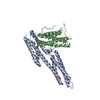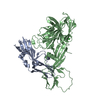| 1 | Sample 1: 0.2 mM [U-15N; U-13C; U-2H] PARP-1 1, 0.2 mM DNA (45-MER), 50 mM [U-2H] TRIS, 1 mM [U-2H] DTT, 0.1 mM ZnSO4, 95% H2O/5% D2O | 95% H2O/5% D2O| 2 | Sample 2: 0.2 mM [U-15N; U-13C; U-70% 2H] PARP-1 1, 0.2 mM DNA (45-MER), 50 mM [U-2H] TRIS, 1 mM [U-2H] DTT, 0.1 mM ZnSO4, 95% H2O/5% D2O | 95% H2O/5% D2O| 3 | Sample 3: 0.2 mM [U-98% 2H; U-98% 15N] PARP-1 1, 0.2 mM DNA (45-MER), 50 mM [U-2H] TRIS, 1 mM [U-2H] DTT, 0.1 mM ZnSO4, 95% H2O/5% D2O | 95% H2O/5% D2O| 4 | Sample 4a: 0.2 MM PARP-1 1-214, Uniform [2H,15N,13C], back-labeled with [1H,13C] in the delta-methyl groups of Ile and all methyl groups of Leu and Val residues, using sodium [4-13C, 3,3-2H2] alpha-ketobutyrate and sodium [3- 2H, 4,4'-13C2] alpha-ketoisovalerate as precursors to maximize protonation of methyl groups, for use in NOE experiments; sodium [3-2H, 4,4'-13C2] alpha-ketoisovalerate was prepared from sodium [4,4'-13C2] alpha-ketoisovalerate by exchange with 2H2O at pH 12.5 and 45 C for 3 hrs. 0.2 mM DNA (45-MER), 50 mM [U-2H] TRIS, 1 mM [U-2H] DTT, 0.1 mM ZnSO4, 95% H2O/5% D2O | 95% H2O/5% D2O| 5 | Sample 4b: 0.2 MM PARP-1 1-214, Uniform [2H,15N,13C], back-labeled with [1H,13C] in the delta-methyl groups of Ile and all methyl groups of Leu and Val residues, using sodium [3,3-2H2,13C4] alpha-ketobutyrate and sodium [3- 2H,13C5] alpha-ketoisovalerate as precursors to produce linear chains of 13C in the sidechains of Val and Leu, for use in assignment experiments to link methyl signals to C-alpha signals. 0.2 mM DNA (45-MER), 50 mM [U-2H] TRIS, 1 mM [U-2H] DTT, 0.1 mM ZnSO4, 100% D2O | 100% D2O| 6 | Sample 5: 0.2 MM PARP-1 1-214, Uniform [2H,15N,13C], back-labeled with [1H,13C] in the methyl groups of Met residues in addition to Ile, Leu and Val methyl groups as in sample 4a. 0.2 mM DNA (45-MER), 50 mM [U-2H] TRIS, 1 mM [U-2H] DTT, 0.1 mM ZnSO4, 100% D2O | 100% D2O| 7 | Sample 6: 0.2 MM PARP-1 1-214, Uniform [2H,15N,13C]; back-labeled with [1H,13C] in the methyl groups of Ile, Leu and Val methyl groups as in sample 4a and [1H,13C,15N] Phe residues. 0.2 mM DNA (45-MER), 50 mM [U-2H] TRIS, 1 mM [U-2H] DTT, 0.1 mM ZnSO4, 100% D2O | 100% D2O| 8 | Sample 7: 0.2 MM PARP-1 1-214, Sortase ligated, block-labelled sample. (N.B. residues 103 and 104 of WT sequence deleted, additional residues LPETGGG inserted between residues 102 and 105; this sample was not used for making any assignments of residues in this region, which is in the flexible linker between domains). Labelling for residues 1-102 (and LPET of insertion): uniform [1H,12C,15N]. Labelling for residues 105-214 (and GGG of insertion): [2H,15N,13C] back-labeled with [1H,13C] Ile, Leu Val and Met methyl groups labeled as in sample 5. 0.2 mM DNA (45-MER), 50 mM [U-2H] TRIS, 1 mM [U-2H] DTT, 0.1 mM ZnSO4, 100% D2O | 100% D2O| 9 | Sample 8: 0.2 MM PARP-1 1-214, Sortase ligated, block-labelled sample. (N.B. residues 103 and 104 of WT sequence deleted, additional residues LPETGGG inserted between residues 102 and 105; this sample was not used for making any assignments of residues in this region, which is in the flexible linker between domains). Labelling for residues 1-102 (and LPET of insertion): uniform [1H,12C,15N]. Labelling for residues 105-214 (and GGG of insertion): [2H,15N,13C] back labeled with [1H,13C] Met methyl groups as in sample 5 and [13C,15N,1H] Arg residues. 0.2 mM DNA (45-MER), 50 mM [U-2H] TRIS, 1 mM [U-2H] DTT, 0.1 mM ZnSO4, 100% D2O | 100% D2O| 10 | Sample 9: 0.2 MM PARP-1 1-214, Sortase ligated, block-labelled sample. (N.B. residues 103 and 104 of WT sequence deleted, additional residues LPETGGG inserted between residues 102 and 105; this sample was not used for making any assignments of residues in this region, which is in the flexible linker between domains). Labelling for residues 1-102 (and LPET of insertion): [2H,15N,13C] back-labeled with Ile, Leu and Val methyl groups labeled as in sample 4a and [1H,13C,15N] Arg residues. Labelling for residues 105-214 (and GGG of insertion): uniform [1H,12C,15N]. 0.2 mM DNA (45-MER), 50 mM [U-2H] TRIS, 1 mM [U-2H] DTT, 0.1 mM ZnSO4, 95% H2O/5% D2O | 95% H2O/5% D2O| 11 | Sample 10: 0.2 MM PARP-1 1-214, Sortase ligated, block-labelled sample. (N.B. residues 103 and 104 of WT sequence deleted, additional residues LPETGGG inserted between residues 102 and 105; this sample was not used for making any assignments of residues in this region, which is in the flexible linker between domains). Labelling for residues 1-102 (and LPET of insertion): [2H,15N,13C] back-labeled with Ile, Leu and Val methyl groups labeled as in sample 4a and [1H,13C,15N] Phe residues. Labelling for residues 105-214 (and GGG of insertion): uniform [1H,12C,15N]. 0.2 mM DNA (45-MER), 50 mM [U-2H] TRIS, 1 mM [U-2H] DTT, 0.1 mM ZnSO4, 100% D2O | 100% D2O| 12 | Sample 11: 0.2 mM see Sample details section PARP-1 1, 0.2 mM DNA (45-MER), 50 mM [U-2H] TRIS, 1 mM [U-2H] DTT, 0.1 mM ZnSO4, 100% D2O | 100% D2O| 13 | Sample 12: 0.2 mM DNA (45-MER), 50 mM [U-2H] TRIS, 1 mM [U-2H] DTT, 0.1 mM ZnSO4, 100% D2O | 100% D2O| 14 | Sample 13: 0.2 mM DNA (45-MER), 50 mM [U-2H] TRIS, 1 mM [U-2H] DTT, 0.1 mM ZnSO4, 95% H2O/5% D2O | 95% H2O/5% D2O| 15 | Sample 14: 0.2 mM [U-15N; U-13C; U-2H] PARP-1 1, 0.2 mM DNA (45-MER), 50 mM [U-2H] TRIS, 1 mM [U-2H] DTT, 0.1 mM ZnSO4, 100% D2O | 100% D2O| 16 | Sample 15: 0.2 mM [U-15N; U-13C; U-2H] PARP-1 1, 50 mM [U-2H] TRIS, 1 mM [U-2H] DTT, 0.1 uM ZnSO4, 200 mM sodium chloride, 95% H2O/5% D2O | 95% H2O/5% D2O| 17 | Sample 16: 0.2 mM [U-15N; U-13C; U-2H] PARP-1 1, 0.2 mM DNA (45-MER), 50 mM [U-2H] TRIS, 1 mM [U-2H] DTT, 0.1 uM ZnSO4, 200 mM sodium chloride, 95% H2O/5% D2O | 95% H2O/5% D2O | | | | | | | | | | | | | | | | |
 データを開く
データを開く 基本情報
基本情報 要素
要素 キーワード
キーワード 機能・相同性情報
機能・相同性情報 Homo sapiens (ヒト)
Homo sapiens (ヒト) データ登録者
データ登録者 引用
引用 ジャーナル: Mol.Cell / 年: 2015
ジャーナル: Mol.Cell / 年: 2015 構造の表示
構造の表示 Molmil
Molmil Jmol/JSmol
Jmol/JSmol ダウンロードとリンク
ダウンロードとリンク ダウンロード
ダウンロード 2n8a.cif.gz
2n8a.cif.gz PDBx/mmCIF形式
PDBx/mmCIF形式 pdb2n8a.ent.gz
pdb2n8a.ent.gz PDB形式
PDB形式 2n8a.json.gz
2n8a.json.gz PDBx/mmJSON形式
PDBx/mmJSON形式 その他のダウンロード
その他のダウンロード 2n8a_validation.pdf.gz
2n8a_validation.pdf.gz wwPDB検証レポート
wwPDB検証レポート 2n8a_full_validation.pdf.gz
2n8a_full_validation.pdf.gz 2n8a_validation.xml.gz
2n8a_validation.xml.gz 2n8a_validation.cif.gz
2n8a_validation.cif.gz https://data.pdbj.org/pub/pdb/validation_reports/n8/2n8a
https://data.pdbj.org/pub/pdb/validation_reports/n8/2n8a ftp://data.pdbj.org/pub/pdb/validation_reports/n8/2n8a
ftp://data.pdbj.org/pub/pdb/validation_reports/n8/2n8a リンク
リンク 集合体
集合体
 要素
要素 Homo sapiens (ヒト) / 遺伝子: PARP1, ADPRT, PPOL / 発現宿主:
Homo sapiens (ヒト) / 遺伝子: PARP1, ADPRT, PPOL / 発現宿主: 
 試料調製
試料調製 ムービー
ムービー コントローラー
コントローラー











 PDBj
PDBj











































 HNCA
HNCA